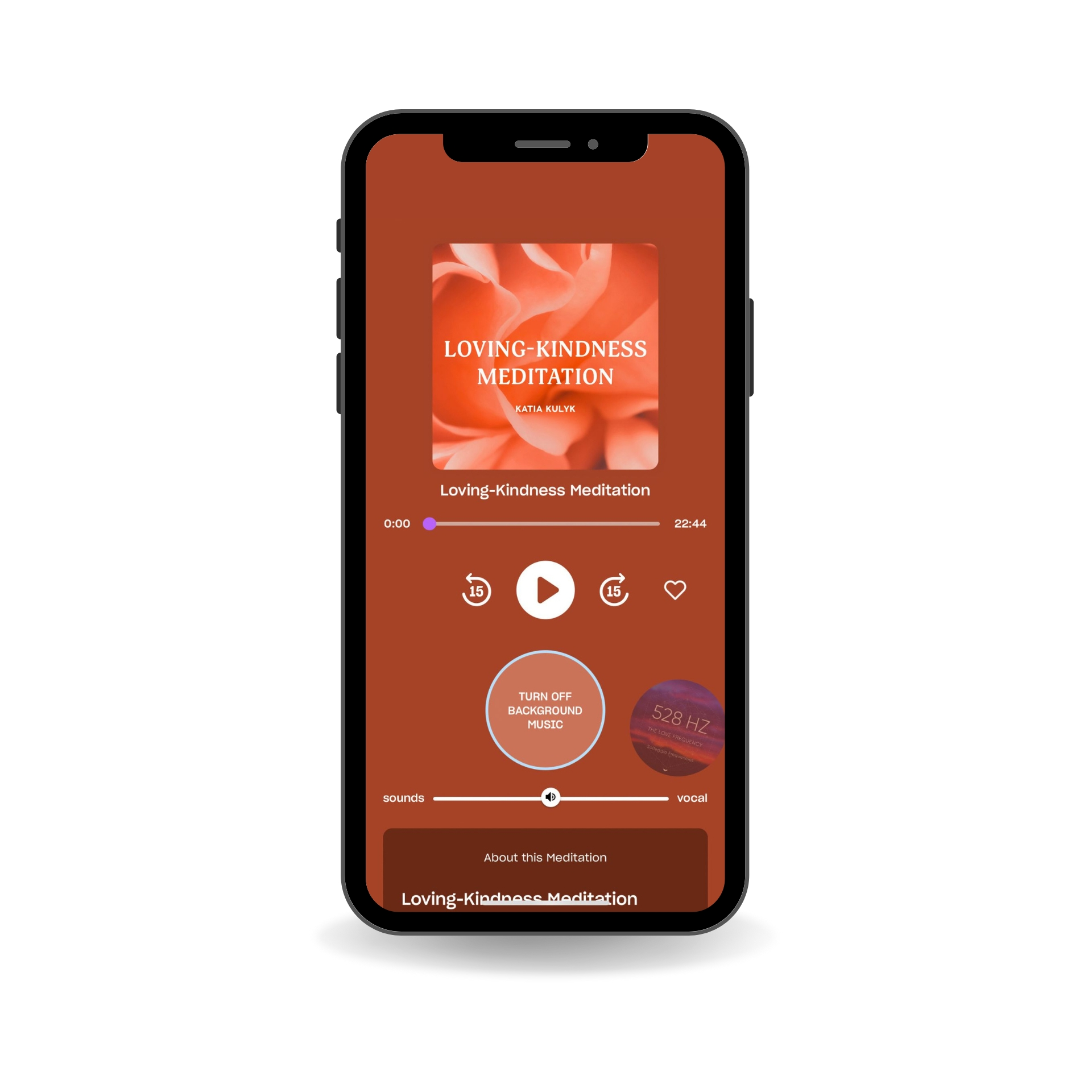Imagine loving yourself for a minute. Like, truly loving yourself.
Instead of spending precious time picking yourself apart, you would actually use that time to build yourself up.
Your first mental reaction to a picture wouldn’t be, “OMG, delete it.” Instead, it would be, “I look so happy.”
You would genuinely compliment yourself like you would a best friend.
And what if your self-love was so great that you couldn’t contain it and let it pour out of you to others, too?
All of this, and so much more, is possible through loving-kindness meditation. But how does it work, and what are the benefits of this meditation practice?
As Gelong Thubten, Buddhist monk and trainer of Mindvalley’s Becoming More Loving program, explains, “Meditation helps us forgive our thoughts. We’re learning unconditional love for our own minds.”
What is a loving-kindness meditation?
Loving-kindness meditation focuses on the feeling of love and kindness in its purest form. This ancient Buddhist meditation, also known as metta meditation, is a beautiful and life-changing element of the Buddhist tradition. Think of it as the perfect antidote for emotions like resentment, hate, and anger.
Its ultimate purpose is to help you uncover boundless, unconditional love, not only for yourself but for all living beings, visible or invisible. Yes, even for that grumpy neighbor of yours.
Loving-kindness is universal in its affection. And this universal quality makes it one of the Four Immeasurables in Buddhism, alongside compassion, sympathetic joy, and equanimity.
How is loving-kindness meditation different?
Loving-kindness meditation works very differently compared to traditional mindfulness-awareness meditations. While it uses mindfulness as its foundation, it also involves generating specific thoughts, ideas, feelings, and emotions.
Now you’re probably thinking, “That can’t be right. Shouldn’t I just be letting what happens happen?” It’s natural—if you’re more familiar with mindfulness-awareness practices, actively directing your mind may feel weird or even suspicious at first.
But the truth is that, by genuinely wishing for the prosperity of yourself and others, you’re not “cooking things up” or getting lost in a daydream. Rather, you’re discovering the innate kindness that lies within you.
Our minds already contain everything we want. We just forget to look. — @Gelong_Thubten Share on XLoving-kindness meditation benefits
Let’s say you’re on your way back from work and you see an injured baby animal on the side of the road. Your first instinct may be to ease the animal’s pain in any way you can.
This somewhat scary but warm sensation of compassion is the essence of loving-kindness. What’s more, its benefits for yourself and others are endless.
Here are some of those benefits, backed up by science:
- Decreases negative emotions and increases positive emotions. Not only does loving-kindness meditation help relieve anxiety and the body’s inflammatory response to it, but a seven-week study demonstrated that “It also increases positive emotions such as love, joy, appreciation, fulfillment, and even awe.”
- Improves social relationships. In a way, loving-kindness meditation helps you satisfy your “longing for belonging.” Research suggests that incorporating it into your daily life can enhance positive social emotions, foster social connectedness, and reduce social isolation.
- Helps improve confidence. If you’ve ever struggled with low self-esteem, you have firsthand experience with the so-called “inner critic”. It’s more than just an annoying voice; it’s downright cruel. According to research, loving-kindness meditation also improves confidence by reducing self-criticism.
- Treats symptoms of PTSD. A study conducted by the United States Department of Veterans Affairs found that engaging in compassion and loving-kindness meditations was just as effective as one of their front-line treatments, cognitive processing therapy, for treating symptoms of PTSD in veterans.
- Fosters feelings of compassion and empathy. Loving-kindness meditation also strengthens empathy and compassion for others, potentially more than any other type of meditation.
The more you practice loving kindness, the more you begin to see the positive in every situation. And the thing is, compassion does not blind you from pain; it helps you find the good in the bad.

How to do loving-kindness meditation
Much like any other type of mindfulness practice, loving-kindness meditation begins by finding a comfortable sitting position. And then follow these steps:
- Close your eyes and connect to the rhythm of your breathing.
- Visualize that you are sitting with someone or something who embodies loving kindness to you; it could be your pet or even a favorite flower of yours.
- Zone in on this feeling of serenity, and imagine that you are breathing out worries and breathing in love.
Once you have entered a mindful state, repeat a few reassuring words to yourself. Here’s a sample of more traditional phrases you can use:
“May I (you / everyone) be well.”
“May I (you / everyone) be healthy.“
“May I (you / everyone) be strong.”
5 steps to spread the loving-kindness around
You begin by saying the phrases to yourself and then to an increasingly wider group. Start with someone you love, then someone neutral, someone you have negative feelings about, and finally, spread this to all living beings.
Let’s break each step of the process down:
- To yourself: Let the love and self-compassion flow through you while saying the phrases you’ve chosen aloud. You can choose to either focus on the self during the entire meditation or begin to shift your focus to others, too.
- To a loved one: Move on to someone you consider very easy to love, like a best friend, a child, or a parent. Don’t choose a romantic partner to avoid feelings of romantic love or lust. Picture them sitting in front of you, smiling at you. Take a moment to really experience that desire for them to be happy.
- To someone neutral: Once you’ve embraced these feelings for that person, branch out to more neutral connections, like the person in line behind you at the bank yesterday, or someone who works at your local grocery store. The goal is to choose someone you don’t have any particular feelings for.
- To someone you have negative feelings about: This can be the most challenging, but it is essential to helping you reach a place of forgiveness and greater peace. Think of a person who has hurt you very deeply. Maybe they betrayed your trust or took advantage of you. If the feelings get too intense, try picturing this persona as a child.
- To all beings: Finally, extend your loving feelings to the world. Imagine your compassion as a light that shines from your heart and encompasses the entire universe and everything in it. Speak your phrases and send them out to wherever life exists.
Let the feeling of warmth and kindness envelope you for a few quiet moments. When you feel that your meditation is complete, take a deep breath and open your eyes.
You can take your meditation with you wherever you go. — @Gelong_Thubten Share on XTo revisit those wonderful feelings you generated, Gelong suggests to “practice micro-moments of mindful awareness many times per day.”
Loving-kindness meditation script
The great news is, there is no right or wrong way to practice loving-kindness meditation.
If you’re doing the meditation on your own, first decide on the phrases you will use. Stick to a small number and keep them as simple as possible, so they are easily repeatable.
Below is a short loving kindness meditation script you can follow:
- “May I (you / everyone) be happy.”
- “May I (you / everyone) be peaceful.”
- “May I (you / everyone) be free of pain.”
- “May I (you / everyone) be free of suffering.”
- “May I (you / everyone) feel safe.”
And if you are new to the practice, try this 20-minute loving kindness guided meditation with Katia Kulyk:, available on the Mindvalley app

The journey to self-love starts from within
Self-love does not happen overnight. But with time, it settles itself into your heart.
Yes, you may struggle. But when looking back on these moments of growth, you’ll realize they were stepping stones on your journey to being the best version of yourself.
And if you’d like some help tapping into your inner love and happiness, Mindvalley programs like Gelong Thubten’s Becoming More Loving, Jeffrey Allen’s Duality, and Sadhguru’s A Yogi’s Life to Joy can guide you along the way.
By unlocking your free account, you will be able to:
- Enjoy new guided meditations daily,
- Gain access to the first lessons of these programs,
- Join a worldwide community of individuals who have experienced the transformative powers of meditation, and
- So much more.
According to Sharon Salzberg, meditation expert and pioneer of one of the Western world’s most respected retreat centers, “Real happiness is the ability to self generate a sense of stability, presence, and love and find the source of happiness not dependent on conditions.”
And a happier version of you is only a few breaths away.
Welcome in.








